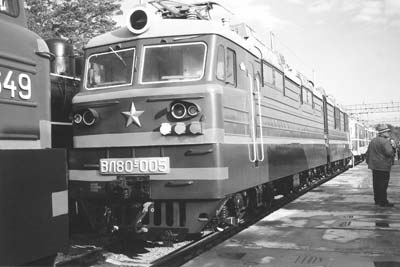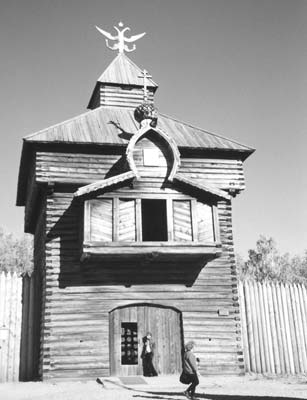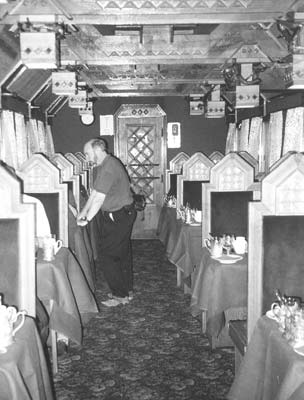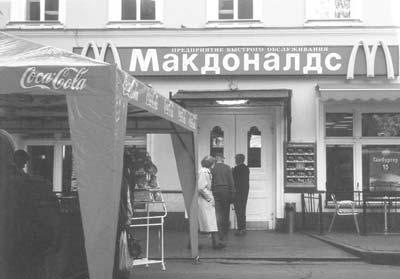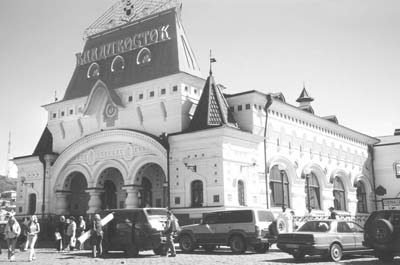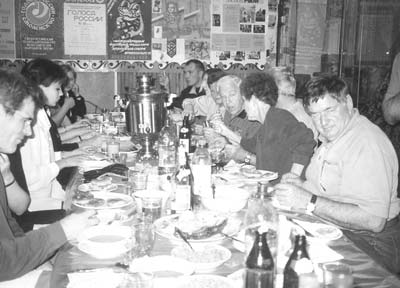Crossing Russia in style on the Trans-Siberian Railway
by Lynn Remly, Arlington, VA
Clattering across eight time zones, the Trans-Siberian Railway line traverses one-third of the globe and all of modern Russian history. While continuing to provide basic transportation in an area with few roads, the train also serves as a draw for hard tourist cash to help kick-start the limping post-Soviet economy.
While most people take the Vladivostok-Moscow route in worn-out cars with primitive facilities, I opted to traverse the 5,806 miles (9,288 kilometers) in style on a private train traveling along the classic route south of Lake Baikal.
Getting there
I booked the entire September ’03 trip, “Russia by Private Train,” through Renee Van Drent at MIR Corporation (Seattle, WA; phone 800/424-7289 or visit www.mircorp.com), including all flights and an additional side trip to St. Petersburg to see the Amber Room at the Catherine Palace. MIR Corporation is the U.S. agent for GW Travel, Ltd. (www.gwtravel.co.uk), the London-based tour operator.
I opted to do the longest flight at the beginning of the trip, and so flew from Washington (Dulles) to Frankfurt and on to Moscow with Lufthansa, then to Vladivostok with Aeroflot. Aeroflot, incidentally, has improved its formerly life-threatening domestic service, and this final leg on a huge Airbus was well up to international standards, with excellent service.
Transfers and hotels were included throughout the regular portion of the trip, so, nearly comatose after 18 hours’ flying and a 3-hour delay at the Moscow airport, I was taken to the Hotel Hyundai (29 Semenovskaya St.; phone +7 4232 402233 or visit www.besteastern.com), a modern, Korean-built hotel set on a hill overlooking Golden Horn Bay.
My immediate realization upon reaching Vladivostok was that the Russian Far East looks eastward for trade. Korean tour groups abound, and the majority of cars on the road are used, right-hand-drive models imported from Japan. Korean foods, like dried octopus and kimchee, are available everywhere; some were even offered on our included buffet breakfast at the hotel.
Vladivostok
As the home of the Pacific Fleet, Vladivostok, clinging to a swatch of land at the far eastern end of the continent, was closed even to Russians until a few years ago. Today, however, the feeling is all openness. In fact, the city was hosting a film festival the week of my visit.
Anticipating the need for some rest after my long flight, I had booked an extra day in Vladivostok, and after a good night’s sleep and a solid breakfast I wandered down to the water to look at the ships and breathe in the sea air.
Eventually, I found my way downtown to the Arsenyev Museum, which featured a number of representations of the Siberian explorer V.K. Arsenyev and his native guide, Dersu Uzala, immortalized in the Akira Kurosawa film “Dersu Uzala.” Although a bit out at the elbows, the museum was a wonderful introduction to the history, flora and fauna of Primorskii Krai, the easternmost province of the Russian Federation. In the museum, pride of place was given to the Amur tiger, the highly endangered symbol of this region.
Various native costumes, church memorabilia, Victorian furniture and all the eclectic exhibits were, fortunately, explained, for the most part, in Russian and English, with an occasional Korean or Japanese caption thrown in.
After purchasing an ice cream cone at the amusement area on the beach, I returned to the hotel for a dinner organized by GW Travel, Ltd. The majority of the 52 travelers on this tour were from New Zealand, and they were delighted, for once, to be in the majority.
The next day, we all piled into buses for a city tour, which included lunch at the Vladivostok train station. The station had recently been restored in the old Imperial style, with Russian scenes painted on the ceilings and portraits of Peter the Great and others filling medallions. The afternoon was spent in visits to the university, Vladivostok Fortress and a World War II submarine, then we returned to the station to embark late in the day.
The train
I had wanted to take the Trans-Siberian for many years but was put off by stories of sharing compartments with strangers, a lack of showers, ubiquitous smoking and primitive toilet facilities. Our private train, the Trans-Siberian Express, addressed all these concerns. It included three first-class cars, two deluxe cars, two dining cars decorated in the old Russian style, a bar car, an office car, a shower car, two kitchens and staff cars.
The first-class cars provided a samovar so that occupants could always make tea, coffee or soup. The deluxe cars, however, offered 24-hour service for coffee, tea and cookies.
Each first-class compartment had two parallel sofas that converted into twin beds. Each deluxe car had a large twin/double bed below and a twin bed above, along with a larger table and upholstered bench area.
While first-class passengers shared the car toilets and showered in a separate car, deluxe passengers had a large bathroom with washstand, commode, a generous shower and large bottles of shampoo and soap provided. For me, personally, the extra money I spent for private facilities was worth it.
Heading out
After taking photos at the 9,288-kilometer marker, our group headed off on the longest rail trip in the world. Visiting towns along the route was one of the great advantages of taking the private train; while the regular train simply continued on day after day, stopping only to pick up passengers, deliver mail and take on supplies, our train was diverted onto a siding at major stops so that we could see something of life there on the other side of the world.
After passing within two miles of the Chinese border, we arrived the next day in Khabarovsk, a city of 660,000 that few people in the West have heard of. The point farthest east on the line, the city was full of surprises, including elegant public and private buildings along wide boulevards and a rebuilt cathedral in Cathedral Square.
We stopped for an impressive view of the mighty Amur River as we crossed on the longest bridge (2.5 kilometers) on the Trans-Siberian line, the last section of the railway to be finished in 1916. I made a mental note to put a return visit to Khabarovsk on my “to do” list.
We spent the next two days doing what we came for, experiencing the vastness of Russia east of the Ural Mountains. We were told that this huge territory is actually divided into the Russian Far East (main city, Vladivostok), eastern Siberia (main city, Irkutsk) and western Siberia (main city, Yekaterinburg).
It was mesmerizing, watching mile after mile of tiny villages in the taiga (birch forest) clinging to the rail line, their lifeline. The carefully fenced smallholdings had electricity but no plumbing, and cabbages, potatoes and goats thrived in every yard, along with the occasional cow for morning milk. The scenes we saw must have been played out in Siberia from time immemorial.
Buddhism & The Old Believers
On day four, our arrival in Ulan Ude was a further culture shock, since the town is very close to the Mongolian border and has become the center of Buddhism in the Russian Federation. The Buryats, who comprise a large portion of the 450,000-strong population, are descendant of Ghengis Khan but adhere to Tibetan “Yellow Hat” Buddhism.
We visited the Ivolginsk Datsan (monastery), a complex of several buildings that also included prayer wheels of stupendous size and whose trees were filled with prayer flags. Pictures of the Dalai Lama were everywhere, flanking a huge Buddha.
For contrast, we joined a group of Old Believers, who were awaiting us on a hillside beyond their 17,000-strong village of Tarbagatay. The Old Believers derive their name from their rejection of reforms introduced in the 17th century to the texts and practices of the Russian Orthodox Church.
Dressed in traditional costume and singing in the old style, a capella, they took us to the village, where we had a dinner of a dozen or so dishes, including fish, meat, kasha, potatoes, cabbage salad, pancakes with honey, and tomatoes with cheese, all washed down with Georgian wine and, of course, vodka.
The singers entertained us wonderfully after the meal and even sang a poignant rendition of “Shenandoah” for us, along with Cossack songs. (UNESCO has proclaimed the Cultural Space and Oral Culture of the Semeiskie [Old Believers] a Masterpiece of Oral and Intangible Heritage of Humanity. For more, visit www.unesco.org/bpi/intangible_heritage/russia.htm.)
Lake Baikal
The next morning we awoke to Lake Baikal. At more than a mile deep, it is the deepest freshwater lake in the world. It contains enough fresh water to supply the entire world’s needs for 40 years and plays host to flora and fauna seen nowhere else, such as freshwater seals and sponges.
Legend has it that if you wash your hands in the water, you increase your lifespan by five years. If you wash your face, you add 10 years. If you swim, you add 20 years — but only if you survive the swim in the 50- to 60-degree water.
Lunch was a barbecue picnic on the shore of the lake, and one intrepid Kiwi did take a swim (and survived), thus ensuring his longevity. Afterward, we were allowed to actually climb onto the engine for a ride, probably giving insurance agents across the world heart palpitations.
After heading on to Port Baikal on a branch line, we took a hovercraft across the mouth of the Angara River to Listvyanka, where we visited the village and the limnological institute. The Siberian village was built in traditional wooden style, with a fortress, church and farmstead. Young people in traditional costume were practicing for some kind of performance, singing one song which dealt with a young girl flirting with soldiers until her mother intervened and chased the soldiers away. Some things seem to be universal.
The Limnological Museum focuses, of course, on the lake. An excellent video showed summer and winter explorations of the waters, by scuba, remote camera and mini-sub. There was enough in the museum to fill shelves of books, all of them pointing to the same conclusion: namely, Baikal is indeed the “Pearl of Siberia.”
Irkutsk
At our next stop, Irkutsk, we were treated to a tour of the city, including Gagarin Esplanade — named after the first man in space — and traditional Siberian wooden houses, decorated with elaborately painted windows. The houses themselves are never painted; they are constructed of larch, which is resistant to rot and therefore requires no protection. The windows, however, are most often painted light blue, just for decoration.
By this time, I had contracted a cold and had run out of my cold medicine from home, so I asked to see Dr. Raisa, the train’s medical representative. All of the Trans-Siberian trains have doctors aboard, simply because there is little access to medical help in the outback of beyond. Although Raisa spoke no English and I speak little Russian, she managed to supply me with remedies for my various symptoms.
Irkutsk deserves its unlikely appellation, “The Paris of Siberia.” It was the home of the Decembrists, a group of progressive aristocrats who attempted to initiate reforms leading to representative democracy. Czar Nicholas I was not amused and sent them to Siberia, where many attempted to re-create the life they knew in Moscow and St. Petersburg.
We visited the house of Sergey Volkonsky, Tolstoy’s prototype for Prince Bolkonsky in “War and Peace.” Like several others, his wife, Maria Volkonsky, joined her husband in exile and managed to create a salon that drew artists from all over Europe. While their house seemed to us magnificent, it probably suffered in comparison to the palaces they had left in Moscow and St. Petersburg.
After a tour of the house, we were treated to a surprise concert for piano, voice and violin, featuring works by Schubert, Chopin, Glinka, Tchaikovsky and others, with champagne afterward. Sitting in the elegant, candlelit room, it was easy to imagine ourselves back in the first quarter of the 19th century, enjoying an elegant soiree given by Maria Volkonsky.
Krasnoyarsk
The next day brought us to the halfway point on our 5,806-mile journey. We crossed one of Siberia’s largest rivers, the Yenisei, and arrived in Krasnoyarsk. We took a bus through a nature preserve to Divnogorsk to see the huge hydroelectric dam that harnesses the river as it heads north to the Arctic. Colorful cloth tied by locals to the trees on the outlook over the river for good luck, especially for a wedding or birth, added color to the already splendid color of fall leaves on the banks.
The local literary museum honored favorite son Viktor Petrovich Astafyev, a novelist who spoke out against the Stalin regime. Its eclectic collection also featured exhibits showing exiles going off to Siberia in leg chains and the road blocks they encountered on the long trip to nowhere. When we see the railway today, with trains whizzing by every three minutes, it’s easy enough to forget the slave labor that built and maintained the lines in both the 19th and 20th centuries.
Importance of railroads
Our daily bulletins in the train featured the day’s tour plus other events and included a brief geography lesson, such as, “By Krasnoyarsk, we are directly above Lhasa, Mongolia and Burma.” The expanse of the Russian Federation is difficult to comprehend, even as you cross it. Many of us were marveling daily at our maps, trying to get our minds around the vast distances we were traversing.
At Novosibirsk, our group divided along interest lines. One busload went shopping, while I elected to take the other bus to the Western Siberian Railway Museum. The museum boasts a huge collection of steam, diesel and electric locomotives plus carriages and equipment. Specialty cars, such as track-laying carriages, huge snowplows and Imperial coaches, made clear how huge an enterprise railroads have always been in Russia — especially in Siberia, where there are few roads — and how huge an enterprise they continue to be.
Yekaterinburg
During the entire trip I had been looking forward to Yekaterinburg, where Czar Nicholas II and his family were assassinated by the Bolsheviks at midnight on July 16, 1918. The house in whose basement the couple and their five children were shot, then beaten and splashed with acid to make their corpses unrecognizable, is long gone, but a beautiful new church has been erected on the site in their memory. The members of the family have been canonized, and icons showing the family group were everywhere.
As I made my souvenir purchases, the attendant in the gift shop excitedly asked the guide where I was from. When I replied, “Washington, D.C.,” she said, “Say ‘Hello’ to everyone in Washington.” This is not your grandfather’s Russia.
We also visited the Urals Mineralogical Museum, the spectacular outgrowth of one man’s private collection. Interestingly, the minerals, many of which I had never seen, were displayed along with carvings or other objets d’art made from the same minerals. It was like visiting the Museum of Natural History and the National Sculpture Gallery at the same time. A wonderful gift shop gave us the chance to purchase unique jewelry and art objects at very reasonable prices.
We occasionally had lunch or dinner off the train, and here we ate crepes with sour cherries in a Siberian-style restaurant called Once Upon a Time. As a vegetarian, I usually ask for a special meal, and all of the restaurants we visited on this trip were very accommodating and had excellent food and service.
On to St. Petersburg
After an evening tour of the Kungur caves nearby, we left Yekaterinburg, marking the end of Asia and the beginning of Europe. We spent the following day on the train, rolling inevitably across miles of territory, including the Volga River. I was glad to have time to repack my suitcases, now considerably heavier than they had been at the start of the trip.
Those who wanted could attend a couple of lectures, one on the Trans-Siberian and the beginning of GW Travel’s business, the other about life in the Soviet Union and the disruption that came with its dissolution. It also was time to settle onboard accounts and purchase a few last souvenirs, such as Imperial-style red-and-gold towels or silver tea-glass holders.
The next day, we arrived in St. Petersburg, which had been considerably spiffed up because of its 300th anniversary celebration. We enjoyed a city tour and visited the Church of the Savior on the Spilled Blood, built on the spot where Czar Alexander II was assassinated, and the Hermitage Museum. We then had a snack lunch on one of the bateaux plying the city’s canals, listening to singers perform traditional Russian music and watching the beautiful buildings of the city go by.
In the evening, we had the option of attending either a ballet (“Swan Lake” or “Giselle”) or an opera (“La Traviata”). I opted for “Giselle,” which was performed by dancers from the Mariinsky Theater (the Kirov) in the small Hermitage Theater in the Winter Palace, where Catherine the Great entertained her guests. The drive back to the station through the quiet streets offered a good look at the city’s sights, uncomplicated by traffic.
The end of the line
We boarded the train near midnight for our last night, arriving in Moscow the next day. While our luggage was taken to Hotel Baltschug Kempinski (Ul. Balchug, 1; phone +7 501 230 6500, fax +7 501 230 6502 or visit www.kempinski-moscow.com), we toured the city. My first trip to Moscow had been in 1972, and I was predictably amazed by the changes. During my first trip, which was at Christmastime, I was depressed by the scant supplies in the huge GUM department store, to say nothing of its shabby appearance. Now, the galleries are home to the most fashionable stores: Escada, Hugo Boss, Lanvin. . .
After a very comfortable night in the Kempinski, I headed back by plane to St. Petersburg to see the restored Amber Room in the Catherine Palace in Pushkin. I had arranged a private guide and driver, as well as the flight and hotel, through MIR, and I was glad that I had.
My guide took me to the Gold Room in the Hermitage and later knew how to snake through crowds of tourists standing in the rain outside the palace so that we were almost the first in when it opened. The Amber Room would have been worth any trouble, but I was glad to have had none.
Afterward, we visited the Alexander Palace in Pushkin and the lovely Pavlovsk Palace in a neighboring suburb. Following lunch at a charming, old-fashioned restaurant, we went back to visit the Peter and Paul Fortress in town and then did some shopping (at my request) at Red October (8 Blokhina Ulitsa), a one-stop souvenir shop par excellence, where anything from expensive amber jewelry to inexpensive matryoshka dolls can be purchased.
The driver dropped us off at Hotel Arbat-Nord (Artilleriyskay Street 4), a new, European-style hotel on a quiet side street, where we tried to get some rest before our early flight home the next morning.
Based on this experience, I hope to return to Siberia, either by means of the northern (or BAM) route of the Trans-Siberian Railway or by individual visits to some of the places I enjoyed. I have seen and heard many stories about the regular Trans-Siberian, including a 1969 PBS video. I probably would never have taken this trip but for the possibility of a private train, which, in addition to being far more comfortable, also offered the chance to really see some of the cities of Siberia.


